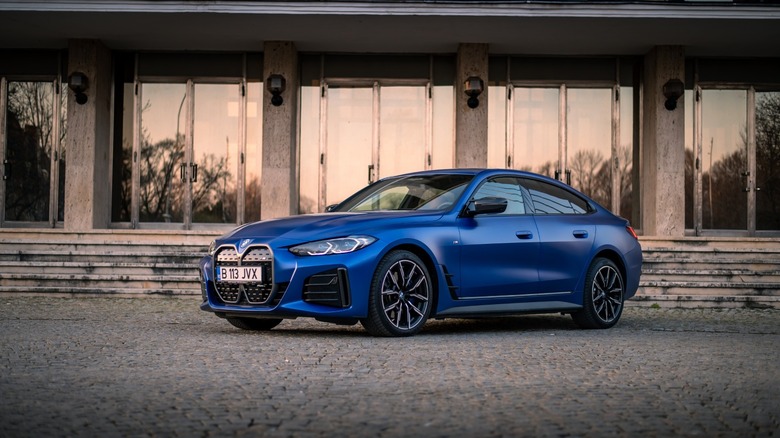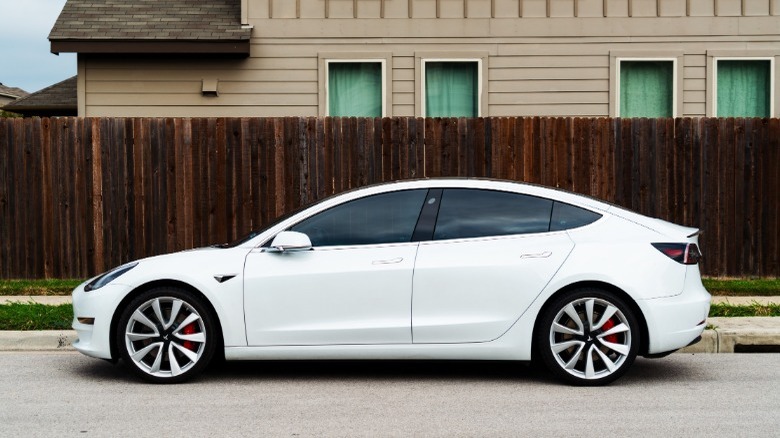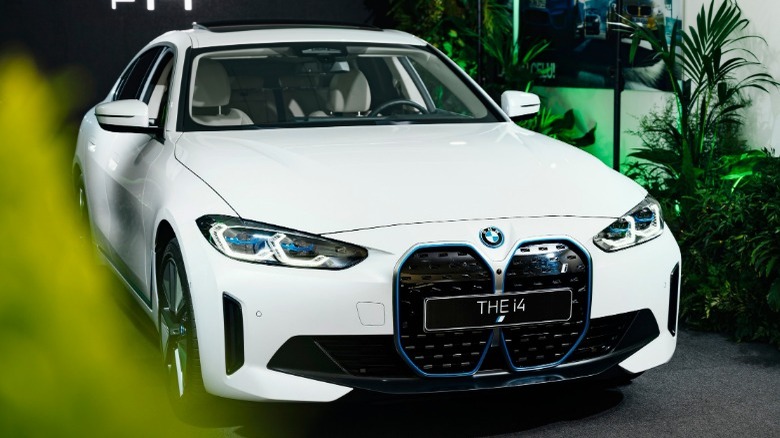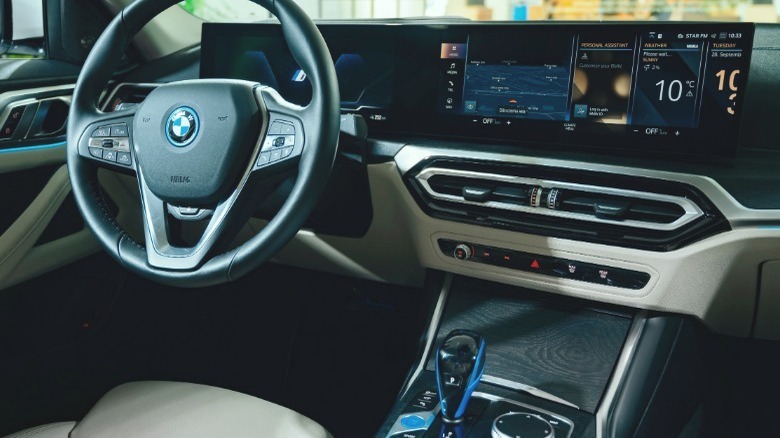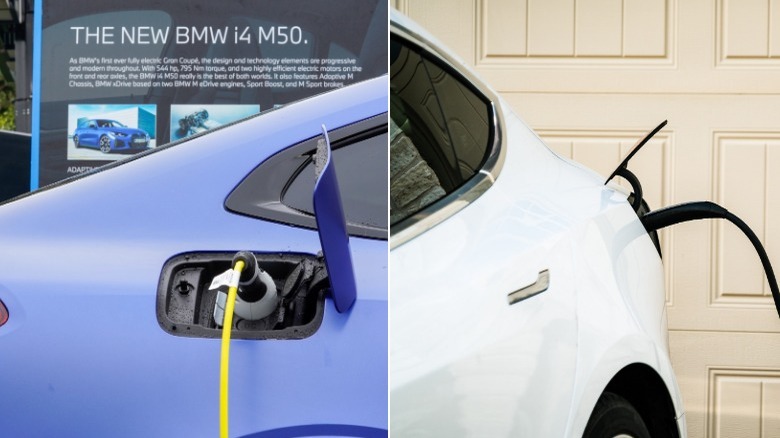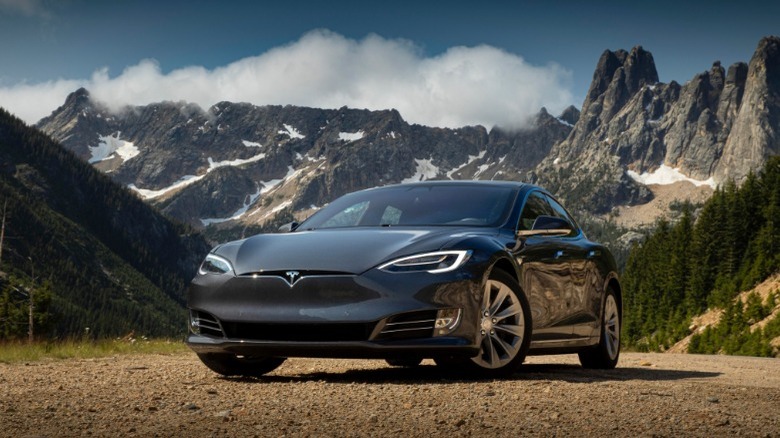Tesla Model 3 Vs BMW i4: Which Is The Better Electric Car?
BMW was ahead of the pack when it launched the i3 and i8 back in 2013, but the German auto maker seemingly gave up on the electric race until 2020 when it announced the iX3. BMW is continuing its renewed efforts in the all-electric space, this time taking on the Tesla Model 3 with the i4 in its various permutations.
The Model 3 is Tesla's cheapest car so far, making it tough EV competition to beat. Though the BMW i4 isn't much more expensive than the Tesla Model 3, it will have to prove the extra spend is worth it ... if it wants to knock the Model 3 off the top spot as the most popular electric car in the United States. Now that Tesla's Supercharger network is opening to other manufacturers, the company also has less of an advantage when it comes to ecosystem and the trade-offs usually spoken about when electric cars are mentioned.
The Tesla Model 3 is the de facto electric sedan
The Tesla Model 3 is a luxury, compact, sport sedan that launched in 2017 and quickly rocketed itself to the top-selling electric vehicle spot in the U.S. The Tesla Model 3's dominance comes from more than just being the first kid on the block. It is a genuinely well-put-together vehicle. Starting at $48,490 for the Standard Range RWD model, but jumping up to $63,490 for the base Performance trim with AWD, the Model 3 can be both a substitute for an upper-mid-range sedan or a high-end premium family car that delivers a lot in terms of value for money.
According to EV Database, the base RWD Model 3 is equipped with a 60 kWh battery pack that feeds a single motor that allows the car to output a modest 279 horsepower and 450 pound-feet of torque. The top-end AWD Model 3 Performance bumps the battery capacity up to 82 kWh and pushes the motor to achieve a very respectable output of 450 horsepower and 471 pound-feet of torque.
The BMW i4 is an electric 4-series
The BMW i4 is essentially an electric conversion of the BMW 4-Series Gran Coupe, which gives the car a familiar feel compared to the minimalist designs of all-electric manufacturers like Tesla. Unfortunately, taking a gas car and slapping an electric powertrain under the hood comes with a few drawbacks. For one, the i4 still has gaps in the rear trim for exhausts — a feature that might make the car look sportier, but might also come across as goofy if you think about it too long.
The BMW i4 starts with the eDrive35 — set to start delivery in early 2023, according to BMW's press release — which features a 70.2 kWh battery feeding a single RWD motor that puts out a claimed 282 horsepower and 295 pound-feet of torque, and starts at $55,900. The i4 eDrive40 steps the battery capacity up to 83.9 kWh, and upgrades the rear-mounted motor to give the vehicle 335 horsepower and 317 pound-feet of torque. At the high end, BMW also offers the i4 M50 model, which keeps the same battery pack as the eDrive40, but ups the ante with a dual-motor, all-wheel-drive setup that BMW says produces 536 horsepower and 586 pound-feet of torque (via BMW). The M50 trim level of the i4 comes in at an MSRP of $65,900 without any optional extras.
BMW makes no claims about complete autonomy, but the i4 still offers Dynamic Cruise Control, Lane Departure Warning, Active Blindspot Detection, and a number of collision warning and mitigation systems as standard equipment, according to the 2023 i4 specification guide. BMW also offers partially-automated driving with the Driving Assistance Professional Package, but that's a $1,700 optional extra only available with the i4 M50 variant.
The BMW's interior is refined, but the Tesla's is more spacious
BMW has been making luxury vehicles for a long time, and that shows in the i4 — for better or worse. The interior of the i4 can be decked out with everything from Alcantara to leather, ash wood, or carbon fiber. The i4's more traditional interior is less polarizing than the Model 3's minimalist presentation that's almost entirely devoid of tactile feedback. More concerning are common complaints about interior build quality of Tesla vehicles. A point in Tesla's favor is that heated seats and steering wheel are only available as an option on the BMW i4, while the Model 3 has both as standard equipment.
BMW features both wireless Android Auto and Apple CarPlay, while the Tesla only has the manufacturer's built-in entertainment suite. Despite the lack of integrated CarPlay or Android Auto, the 15-inch display in the center of the Model 3's dash offers support for a variety of apps, including Spotify, Netflix, and YouTube, among others. The BMW i4, on the other hand, features a curved, panoramic, touchscreen display running BMW's surprisingly flexible iDrive 8 infotainment system to display vehicle information and a host of other information thanks to the iDrive apps and widgets.
According to Top Gear, the i4 inconveniently lacks a front trunk, which is perhaps a consequence of adapting an ICE platform to electric, as opposed to Tesla's electric-only design. MotorBiscuit reported that the Model 3 also has a leg-up over the BMW in terms of rear legroom. Despite being electric, the BMW i4 inexplicably still has a transmission tunnel running through the rear passenger compartments, while the Tesla Model 3 instead has open space in the rear central footwell.
BMW's range falls short, but not significantly
Range is normally where Tesla's competition falls apart, but not necessarily so with the BMW i4 — at least not all the time. Starting at the bottom, the Model 3 Standard Range RWD version has an estimated range of 267 miles, while the BMW i4 eDrive35 claims a 260-mile range. The base model i4 isn't far off the RWD Model 3, but the eDrive40 steps up the range to a max of 301 miles, not quite reaching the Model 3 Performance's claimed 315 miles. The AWD i4 M50 then exchanges range for raw performance, coming in at an estimated 271 miles of maximum range (via BMW)
As part of a collaboration with Electrify America, BMW includes two years of complimentary 30-minute charging sessions at Electrify America charging stations, with a waiting period of 60 minutes between charging sessions. According to BMW, the i4 can go from 10% to 80% in 31 minutes if you're charging at 205 kW, or around 108 miles in ten minutes, meaning if you live near an Electrify America charging station, you could do your daily commute for free for two years — although, DC fast charging is not recommended as a daily solution due to the strain it puts on the battery. Tesla, on the other hand, used to offer free charging at its Supercharger networks, but according to Elektrek, that was cut in 2021. Tesla owners still have access to Superchargers, which will fill the Model 3 up for around $11 to $19, depending on the battery capacity of the model in question.
Driving, performance, and verdict
While the Tesla Model 3 Performance model's 0-60 time of 3.1 seconds is slightly faster than the BMW i4's 3.6 seconds, the M50 version of the i4 features Variable Sport Steering and Adaptive M Suspension to help give the car a sportier and more controlled ride. Tesla's Model 3 tops out at between 140 and 162 mph, the fastest i4 tops out at a meager 118 mph, giving Tesla a clear upper hand.
The BMW i4 range sits in an odd position compared to the Tesla Model 3, not quite having a product that competes at the same level, while also providing a reasonable value proposition. The eDrive35 is pricier than the base Model 3 by around $4,000 (before any EV incentives) and delivers a similar package with less range. Going up to $55,900, the eDrive40 steps up the range to overtake the RWD Model 3, but doesn't quite reach the AWD Model 3. Though, the eDrive40 is cheaper by almost $7,000, giving you more budget to spend on accessories and optional features. The M50 seems to be the least practical of the lot, while costing the most — a car focused on fun factor rather than trying to be an everyman's car.
If you're in the market for an electric vehicle, but you're not a fan of Tesla's design or reputation for after-sales service — or lack thereof — or you just want to buy from a more established brand, the BMW i4 is certainly worth a look, especially now that Tesla is not the only player in the game when it comes to charging networks and reasonable range.
